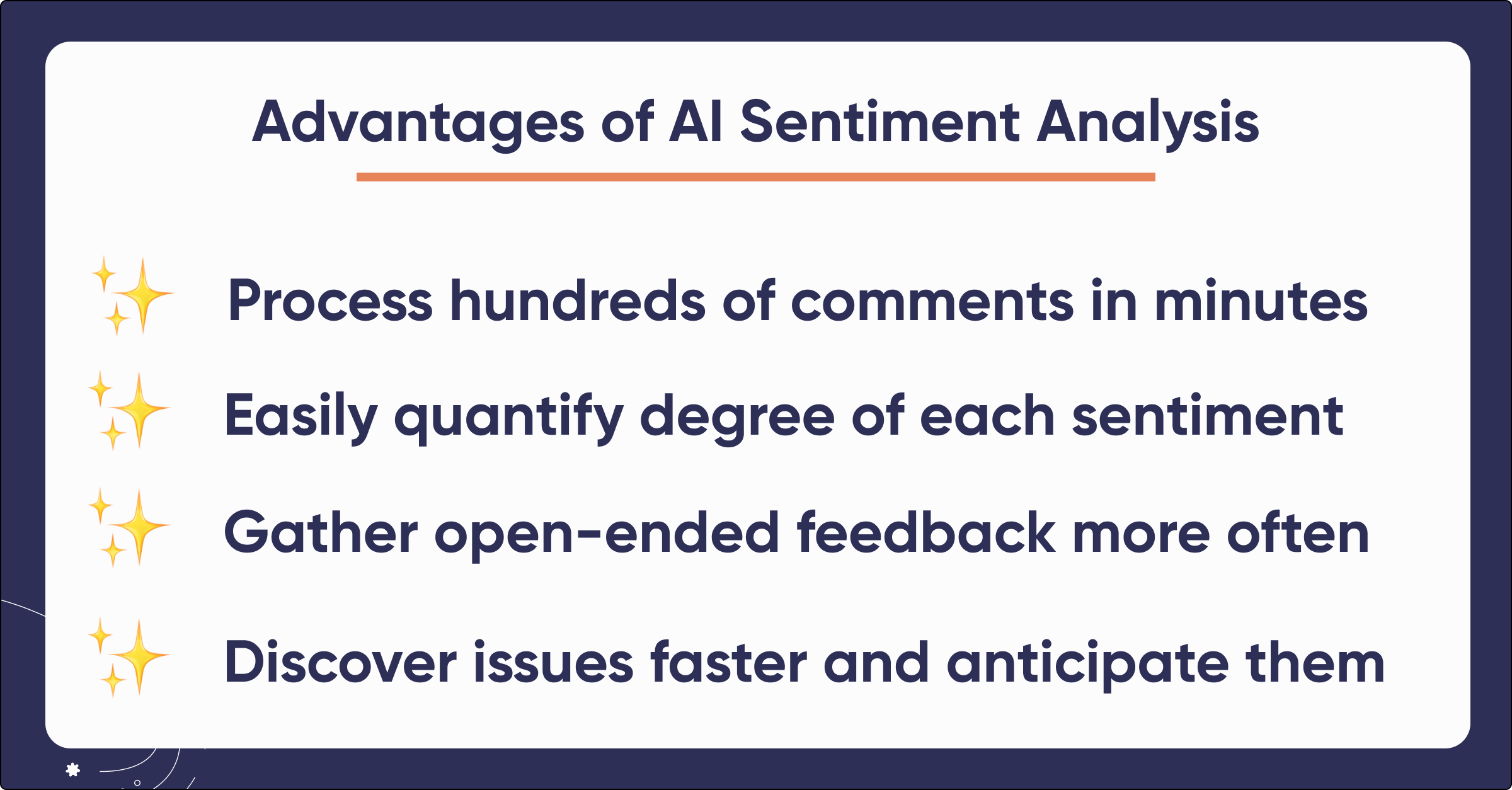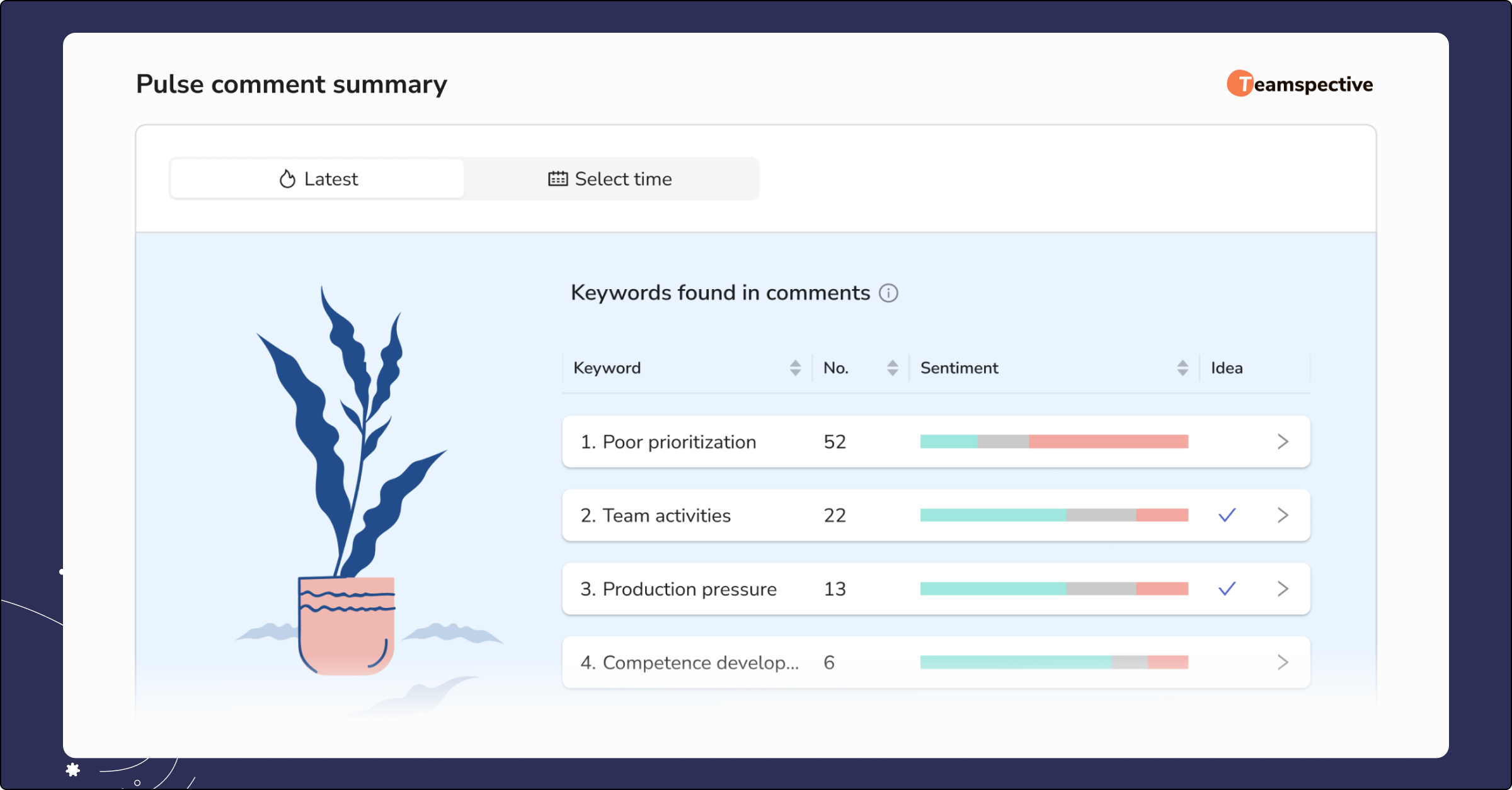Applying AI sentiment analysis in engagement surveys – benefits, applications, implementation
February 1, 2024AI Sentiment Analysis is a powerful tool for accurately understanding employee sentiment on various topics. In this article, you’ll learn how AI sentiment analysis can be used to gain further insights from engagement surveys, how it differs from manual analysis, and what the key benefits are.
AI Sentiment Analysis is a powerful tool for accurately understanding the attitudes and sentiments inside your organization. In this article, you’ll learn how AI sentiment analysis can be used to gain further insights from engagement surveys, how it differs from manual analysis, and what the key benefits are. We also explore how Teamspective’s pulse solution makes it easy for HR managers and leaders to get meaningful insights from open comments and take action in minutes with AI Sentiment Analysis.
How is employee sentiment typically analyzed?
AI sentiment analysis is a relatively new field, and is not used by many companies yet. Employee sentiment is typically analyzed using employee engagement surveys and going through the results manually. For example, pulse surveys using both open and closed questions are a great tool for gathering this data.
Both numeric and open-ended questions are important as each category generates valuable insights into an organization’s strengths and areas of improvement. While closed questions such as pre-populated multiple choice are helpful for gauging the general feelings across the organization, the deeper insights can only be generated by collecting open-ended comments. Open comments may be a quick way to understand more context behind anomalies in numeric data and get development ideas directly from the employees. This makes gathering open comments vital and it’s why Teamspective’s Pulse Surveys automatically prompt users to add open comments when they select low scores in certain questions.
But how does an organization analyze these comments? Typically, this is done manually by an HR Manager, who spends hours or days combing through comments on a spreadsheet, and then creates a summary of the key themes and overall sentiment that surface.
Traditional analysis methods are slow and limited in frequency
While manual analysis of open-ended survey comments is a great way to start getting insights into employee sentiment, it is not without issues, especially in bigger organizations where the amount of data quickly becomes problematic.
- Manually analyzing hundreds of responses is painfully slow.
- Quantifying how prevalent specific issues are compared to each other is hard.
- In-depth analysis typically occurs infrequently (such as every 6 months) due to the amount of time it takes to analyze a single round of comments.
- Because there is a long lag between analysis rounds, it becomes harder for leaders to take action, address sources of negative sentiment or invest more in things generating positive sentiment.
These issues do not mean that manual analysis isn’t valuable. Traditional analysis methods are a great starting point, but you should not stop there. The process can be sped up and results improved significantly using the right tools such as Teamspective’s pulse surveys powered by AI Sentiment Analysis.
What is AI sentiment analysis?
The principle of AI sentiment analysis is simple: it looks at a large amount of text, such as survey responses, identifying repeated topics. Then, it analyzes how positive or negative the sentiment on each particular topic is.
On a more detailed level, AI sentiment analysis is an area of natural language processing (NLP) that involves identifying and categorizing opinions expressed in text to determine the writer’s attitude towards a particular topic. It can be used to determine if a piece of writing is positive, negative, or neutral, and to what degree. It also goes beyond mere word recognition; it understands context and nuances, offering a deeper insight into the emotional tone behind words.
By applying algorithms and machine learning techniques, AI sentiment analysis can be used to process large volumes of text, revealing insights that might otherwise be difficult to discern. It is particularly useful in analyzing things like social media posts, customer reviews, market trends and survey responses.
The fact that AI sentiment analysis works very well for analyzing open-ended survey responses makes it an excellent tool for researching employee sentiment – especially when combined with tools like pulse surveys.
How AI sentiment analysis addresses the issues of traditional employee sentiment analysis?

When applied correctly, AI sentiment analysis can solve the issues of scalability and survey frequency, allowing organization’s leadership to take action faster.
- AI can process hundreds or even thousands of comments in minutes.
- It can easily quantify the degree and volume of each sentiment across the organization or within specific teams.
- Because AI-based analysis is much faster, it allows organizations to gather open-ended feedback more frequently than before.
- As analysis rounds become more frequent, leaders can get a more accurate picture of the organization’s current sentiment, discover issues faster, see if actions taken result in improvements, and put more emphasis on things that are generating positive sentiment – ultimately resulting in better employee engagement.
By effectively implementing AI sentiment analysis, a company can proactively manage and improve employee satisfaction and engagement. However, trying to build this kind of application yourself can take a long time, prove error prone, and become very expensive.
Luckily, there is an easier way - Teamspective’s pulse surveys are powered with AI Sentiment Analysis. It allows you to run frequent engagement surveys directly in Slack or Microsoft Teams, prompting people to leave open comments and generating an immediate overview of employee sentiment with the help of our AI model.
Take immediate action with Teamspective AI Sentiment Analysis
Teamspective AI Sentiment Analysis is a part of our pulse survey solution. It automatically generates a sentiment analysis and summary of pulse comments, allowing the HR Manager to quickly direct attention to the most pressing topics which arise from pulse comments.

- Our AI model is fully calibrated for analyzing engagement survey responses, allowing you to get started immediately.
- Data is shown using user-friendly visualizations, so key issues and development ideas can be seen at a glance.
- HR managers will gain deeper context on what is affecting pulse results in the organization and whether the sentiment is positive or negative.
- Analysis takes minutes from the conclusion of a pulse survey round compared to hours or days of doing manual analysis.
- The solution enables you to implement a faster feedback cycle and build deeper understanding, ultimately allowing you to build a better performing organization.
Want to learn more about how your organization can leverage Teamspective’s AI Sentiment Analysis or want to see a product demo? Get in touch and let’s get started!



